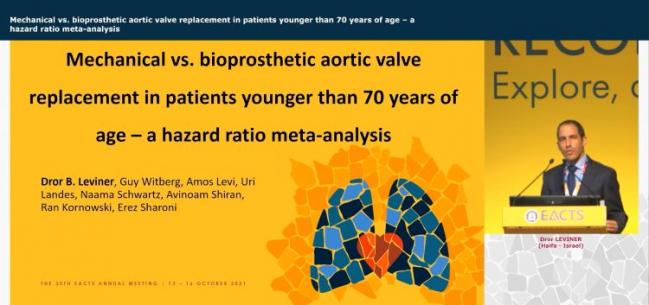More Deaths With Bioprosthetic Than Mechanical AVR in Young AS Patients
Patients tend to want to avoid long-term anticoagulation, but later risks for death and repeat surgeries need to be factored in.

Bioprosthetic heart valves for surgical aortic valve replacement (AVR) are associated with significantly worse outcomes when used in younger patients with aortic stenosis as compared with more-durable mechanical valves, according to results of a new meta-analysis.
The data suggest that physicians and patients might be making detrimental trade-offs with biological aortic valves: avoiding lifelong anticoagulation but increasing the risk of death and reinterventions.
That longer-term risk needs to be acknowledged up front, said lead investigator Dror B. Leviner, MD (Carmel Medical Center, Haifa, Israel), who presented the data last week at the European Association for Cardio-Thoracic Surgery (EACTS) annual meeting in Barcelona, Spain. “With biological valves, the risk of reintervention is way in the future, whereas with mechanical valves the risks of anticoagulation are immediate,” he said.
Guy Witberg, MD (Rabin Medical Center, Petah Tikva, Israel), one of the study authors, said that discussions surrounding the trade-offs of anticoagulation, as well as the potential option of valve-in-valve TAVI should the biological valve fail, are based on assumptions that mechanical and biological valves have clinical equipoise with respect to mortality.
“The moment that assumption that doesn’t hold true, we need to start thinking things over,” Witberg told TCTMD.
Biological vs Mechanical Valves in Surgery
The use of biological valves for surgical AVR is steadily increasing, but there are limited data addressing potential differences in outcomes between biological and mechanical valves for the procedure, particularly in younger patients with a longer life expectancy.
To address the question, the researchers pooled 15 observational studies with propensity-score matching or inverse-probability weighting plus one randomized, controlled trial. Among nearly 17,000 patients younger than 70 years undergoing surgical AVR with either a biological or mechanical valve, use of a biological valve was associated with a significantly increased risk of death (HR 1.22; 95% CI 1.08-1.49). Additionally, use of a biological valve was associated with a more than twofold higher risk of the need for reoperation and a 38% lower risk of bleeding. Stroke rates did not differ between the two groups.
Leviner said the emergence of TAVI has hastened the shift away from mechanical aortic valves, because surgeons feel compelled to compete with the transcatheter procedure by offering patients a biological valve. There’s also a growing assumption that a failed bioprosthetic valve could be treated with TAVI down the road. But the fact that mechanical valves are associated with survival benefits in patients younger than 70, he said, “should lead to reassessment of the current sway in practice favoring bioprosthetic valves in this age group.”
Indeed, the growing use of biological valves in younger patients, said Witberg, is proceeding without any clinical evidence supporting their use.
“I doubt there’ll ever be an adequately powered randomized, controlled trial,” said Witberg. “Even if such a trial were started today, the evidence wouldn’t be in for 10 or 15 years. We have to work with the data we have.”
For surgeon Mateo Marín-Cuartas, MD (University of Leipzig, Germany), who wasn’t involved in the analysis, these new data are reflective of real-world clinical practice. While the meta-analysis has limitations, he noted that all of the observational studies pointed toward worse clinical outcomes with bioprosthetic valves. Although it lacks multiple randomized, controlled trials, the meta-analysis will have important “clinical consequences” as physicians and patients will have to reckon with the higher risk of mortality and need for reintervention if they implant a biological device, he predicted.
At his center, the use of bioprosthetic valves at his center far exceeds the implantation of mechanical valves.
“I see it every day,” Marín-Cuartas told TCTMD. “We barely do mechanical valves. The patient has to be very young to receive one, maybe in their 30s or 40s. Later on, after 50, 55, or 60 years, we’re almost only doing biological valves unless the patient specifically wants a mechanical valve. In these patients, we’re maybe doing one mechanical valve for every 10 or 15 biological valves.”
The fact that this analysis included just one randomized trial is a limitation, conceded Leviner. That study, published in 2009 and led by Paolo Stassano, MD (University Federico II School of Medicine, Naples, Italy), included just 310 patients aged 55 to 70 years old randomized to either a bioprosthetic or mechanical aortic valve.
Guiding Clinical Decisions
Marín-Cuartas said lifelong anticoagulation is an important consideration for patients when it comes to surgical AVR as is the potential option of valve-in-valve TAVI down the road. Related to age, Marín-Cuartas said life expectancy also factors into clinical decision-making.
“If they are in their 50s or 60s, they’re still young,” he said. “Most of them are very active, still working, and they don’t really want to be on anticoagulation. Many patients have other comorbidities, such as atrial fibrillation, so they will have to be anticoagulated, but some of them just have aortic stenosis and nothing else. They don’t have another indication for oral anticoagulation, and they don’t want to be on it.”
Additionally, because patients who receive a mechanical valve must be treated with warfarin, the choice of valve can depend on the patient’s access to clinical care and ability to monitor INR. In countries where access to healthcare is challenging and frequent INR testing is not possible, a bioprosthetic valve can eliminate some of those challenges, he said.
Witberg added that while many patients with aortic stenosis might want to avoid lifelong anticoagulation, which is an important consideration and should be discussed before the procedure, such an option might not be in the cards for them anyway.
“There’s less discussion around the fact that a very significant proportion of these patients who get a bioprosthetic valve because they prefer to avoid anticoagulation will eventually have an indication for anticoagulation, such as for atrial fibrillation,” said Witberg. “Many of them won’t avoid anticoagulation but will have a bioprosthetic valve, which we show puts them at higher risk for mortality.”
Future research is needed to determine in which type of patient biological valves have a higher risk of failure so that an informed decision can be made, said Witberg. Additionally, it would be important to identify patients that might be at a higher risk of atrial fibrillation. If the risk is high, the patient might as well opt for the more-durable mechanical valve, said Witberg.
Marín-Cuartas said the observed mortality difference between the two valves leaves the question as to what is driving the higher risk of death in patients with a bioprosthetic device. It’s possible the increased risk is linked with the higher risk of reintervention.
“Every reoperation increases the risk of morbidity and mortality,” he said. “This might be driving the higher mortality risk. On the other hand, you have bleeding complications of patients treated with a mechanical valve, which could potentially increase the risk of mortality as well. But, in my clinical practice with the patients that I’ve seen, even if they have ‘annoying’ bleeding complications [that] sometimes can be serious, it doesn’t kill the patients.”
Michael O’Riordan is the Managing Editor for TCTMD. He completed his undergraduate degrees at Queen’s University in Kingston, ON, and…
Read Full BioSources
Leviner D, et al. Mechanical versus bioprosthetic valve replacement in patients younger than 70 years of age: a hazard ratio meta-analysis. Presented at: EACTS.
Disclosures
- Leviner, Witberg, and Marín-Cuartas report no conflicts of interest.





Comments